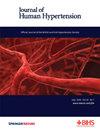血管紧张素1型和2型受体诱导的线粒体功能障碍促进心肌细胞铁下垂。
IF 3.4
4区 医学
Q2 PERIPHERAL VASCULAR DISEASE
引用次数: 0
摘要
以往的研究表明,铁下垂与心血管疾病有关。本研究的目的是探讨血管紧张素II型1和2型受体(AT1/2R)活性与线粒体功能障碍在心肌细胞凋亡诱导中的因果关系。人AC16心肌细胞首先用AT1/2R阻滞剂预处理,然后用血管紧张素II (Ang II)刺激24小时。采用生化方法测定细胞丙二醛(MDA)、超氧化物歧化酶(SOD)和烟酰胺-腺嘌呤二核苷酸磷酸(NADPH)水平,评估心肌细胞的氧化还原状态。流式细胞术检测线粒体活性氧特性(mitROS)、线粒体膜电位和Fe2+水平。western blotting检测谷胱甘肽过氧化物酶4 (GPX4)、血红素加氧酶1 (HO-1)、sirtuin1和铁凋亡抑制蛋白1 (FSP1)-辅酶Q10 (CoQ10)信号通路。我们的研究结果表明,Ang II显著升高心肌细胞中MDA、Fe2+、mitoROS和FtMt的水平,并显著降低心肌细胞中SOD、NADPH、线粒体膜电位、GPX4、HO-1、Sirt1、SFXN1、Nrf2和FSP1的水平,这些水平通过阻断AT1/2R而逆转。我们的研究结果表明,AT1/2R信号可以通过多种信号通路,包括囊肿(e)线/GSH/GPX4轴和FSP1/辅酶Q10 (CoQ10)轴,通过损害线粒体功能诱导心肌铁上吊。本文章由计算机程序翻译,如有差异,请以英文原文为准。

Angiotensin type 1 and type 2 receptors-induced mitochondrial dysfunction promotes ferroptosis in cardiomyocytes
Previous studies suggest that ferroptosis is involved in cardiovascular diseases. The aim of the present study is to investigate the causal relationship between angiotensin II type 1 and type 2 receptors (AT1/2R) activities and mitochondrial dysfunction in induction of cardiomyocyte ferroptosis. Human AC16 cardiomyocytes were first pre-treated with an AT1/2R blockers, before stimulated with angiotensin II (Ang II) for 24 h. The redox status of the cardiomyocytes were assessed by measuring the cellular malondialdehyde (MDA), superoxide dismutase (SOD), and Nicotinamide-adenine dinucleotide phosphate, (NADPH) levels using biochemical methods. Mitochondrial reactive oxygen specifics (mitROS), mitochondrial memebrane potential, and Fe2+ levels were determined using flow cytometry. The signaling pathways, including the glutathione peroxidase 4 (GPX4), heme oxygenase-1 (HO-1), sirtuin1, and ferroptosis suppressor protein 1 (FSP1)-coenzyme Q10 (CoQ10) pathways, were evaluated using western blotting. Our results demonstrated that Ang II significantly elevated the levels of MDA, Fe2+, mitoROS, and FtMt and markedly reduced SOD, NADPH, mitochondrial membrane potential, GPX4, HO-1, Sirt1, SFXN1, Nrf2, and FSP1 levels in cardiomyocyte, which were reversed by blockade of AT1/2R. Our results suggest that AT1/2R signaling can induce myocardial ferroptosis by impairing mitochondrial function via multiple signaling pathways, including the cyst (e)ine /GSH/GPX4 axis and FSP1/coenzyme Q10 (CoQ10) axis.
求助全文
通过发布文献求助,成功后即可免费获取论文全文。
去求助
来源期刊

Journal of Human Hypertension
医学-外周血管病
CiteScore
5.20
自引率
3.70%
发文量
126
审稿时长
6-12 weeks
期刊介绍:
Journal of Human Hypertension is published monthly and is of interest to health care professionals who deal with hypertension (specialists, internists, primary care physicians) and public health workers. We believe that our patients benefit from robust scientific data that are based on well conducted clinical trials. We also believe that basic sciences are the foundations on which we build our knowledge of clinical conditions and their management. Towards this end, although we are primarily a clinical based journal, we also welcome suitable basic sciences studies that promote our understanding of human hypertension.
The journal aims to perform the dual role of increasing knowledge in the field of high blood pressure as well as improving the standard of care of patients. The editors will consider for publication all suitable papers dealing directly or indirectly with clinical aspects of hypertension, including but not limited to epidemiology, pathophysiology, therapeutics and basic sciences involving human subjects or tissues. We also consider papers from all specialties such as ophthalmology, cardiology, nephrology, obstetrics and stroke medicine that deal with the various aspects of hypertension and its complications.
 求助内容:
求助内容: 应助结果提醒方式:
应助结果提醒方式:


